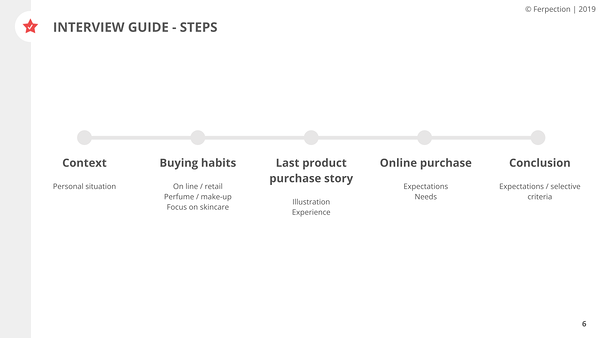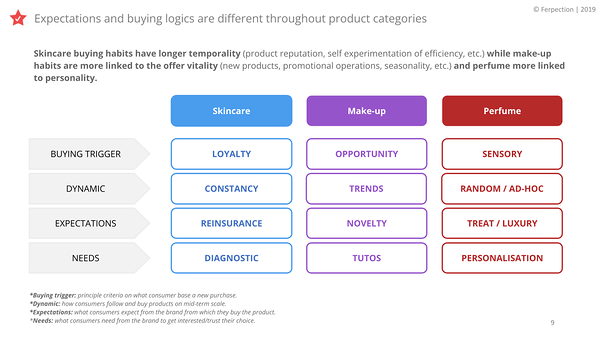April 15, 2022
How to Create a Persona | The Ferpection Method
Building your client archetype with UX research
How to create a persona? At a time when the user is more than ever the top priority for companies, many are realizing the importance of capturing their client archetype. But, beware, because between your true user archetype, misconceptions and your perception of the ideal client, there is sometimes quite a world of difference. UX research can help you see this more clearly by defining the context and questions to ask your sample. By establishing concrete facts and mixing survey methods, your persona will soon be more real than real! We'll explain it to you.
The definition of a persona or client archetype
To begin with, what is a persona?
A persona (also known as a client archetype, ideal user, buyer persona or user archetype), is a representation of a potential target and their behavior towards your product. This character is the fictional incarnation of your client.
It is identified by socio-demographic data and by habits.
A persona is built from the client's perspective, not the company's. The client’s language, needs, and reactions will be very different from those of the company.
Establishing these profiles and behavioral traits is used to design customized products that meet the specific needs of your clients.
A company has many different types of clients. Some products cater to a specific clientele and not all items offered by the company meet the same needs.
Let's take the example of a company specializing in gardening and nature.
Its persona profiles could be:
- the nature lover
- the handyman
- the designer
The products that the company will develop must meet the expectations of each part of its client base.
Once you have built your client archetype, you will have to continue to imagine your future products based on him or her. You will also need to adapt your communication strategy accordingly.
⏩ Discover how a UX testing agency can help me understand my users
Creating your persona: deconstructing false beliefs
One of the first rules when it comes to creating a persona, is to forget your personal beliefs and look for facts. Wanting to create your own persona may seem like a good idea at first: you know your product, and for whom you have designed it. So describing it and telling its story will not be a problem for you. Yes, but there is a problem with this method: at some point, you will inevitably come face to face with your personal beliefs. And these will make you imagine an ideal client who is not necessarily in line with the reality of your market.
It is essential to base your typical profile on facts. To achieve this, the best solutions are UX research and the integration of your users and prospects directly into the persona building phases.
Write a custom persona creation questionnaire
So how do you define the questions to ask your audience? Many companies are tempted to look up sample client archetype questionnaires on the Internet, fill them out, and draw a typical portrait. In our opinion, the method is far from optimal. Why? For the simple reason that the issues on which to focus change dramatically depending on the type of project.
You may be interested in:
- their background
- their upbringing
- their professional path
- their personal situation
- their finances
- their motivation sources
- their pain points
But, in reality, it is useless to ask your users 100 questions if only 20 are relevant. Remember to prepare the scope of your survey when identifying client needs, expectations, and barriers. The best way to do this is to mix interviewing methodologies to design your personas' questionnaire and define their habits.
⏩ Check out all of Ferpection's consulting services for your UX projects
Build a client archetype by mixing qualitative and quantitative approaches
Mixing qualitative and quantitative methods is what we think works best. To this end, we mix approaches according to the needs of our clients and interview both their consumers and their prospects. The qualitative phase, to begin with, provides a clearer vision of usage.
The qualitative phase
For example:
We conducted individual interviews with users who matched the core target group for one of our clients specializing in freeway credentials, and we dug deeper into their mobility needs: reflexes, habits, types of trips, uses, budget, and even the type of apps used.
We then grouped these trends into large families/archetypes and this gave us a preliminary idea of persona. This sketch, still vague, was then confirmed using quantitative methods.
The quantitative phase
When defining how you will conduct your quantitative study, it is important to identify the scope of the project in advance by asking yourself the following questions:
- What sample size do I want to survey?
- Do I need to collect data at a national or international level?
- Am I talking to a B2B or B2C client?
These quantitative surveys therefore provide statistical, numerical and, above all, factual trends: these client archetypes are found between such and such an age group, in such and such a city. It is important to know in which population categories your personas fall, and to identify the uses and ingrained habits specific to this category. Also ask yourself what is the size and potential of each persona? The answer to these questions will make it possible, if necessary, to define the priority type on which to concentrate. This results in more complete user archetypes than the usual marketing buyer personas, which can end up being quite hollow.
To summarize, a persona is a fictional representation of your client, characterized by socio-demographic data and habits.
Its development is based on facts, and it is vital to refrain from including any personal idea of the process.
Drafting a questionnaire template for your persona requires first of all a clear definition of the project, its needs, and approach. Then, you can develop your questions by mixing qualitative and quantitative information.
Questions? Contact us, we are here to listen to you.
If you liked this article, please share it on your social media platforms and subscribe to our newsletter 😉.
Does UX research interest you?
All articles from the category: User research | RSS



